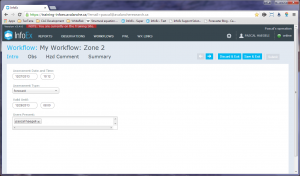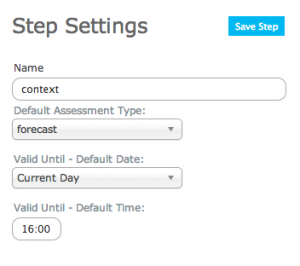Difference between revisions of "Context module"
(→Settings) |
(→Settings) |
||
| Line 23: | Line 23: | ||
*'''Default Assessment Type'''<br/>Specifies the default setting for the assessment type for the workflow. Only two selections are possible | *'''Default Assessment Type'''<br/>Specifies the default setting for the assessment type for the workflow. Only two selections are possible | ||
| − | ** Nowcast: The assessment that examines the current conditions | + | ** ''Nowcast'': The assessment that examines the current conditions |
| − | ** Forecast: The assessment provides a forecast for the near future | + | ** ''Forecast'': The assessment provides a forecast for the near future |
*'''Valid until - Default date'''<br/>Specifies the default date of validity/expiry date of a forecast assessment relative to the assessment date. Options for the setting include ''Current day'' or ''+ x days''. | *'''Valid until - Default date'''<br/>Specifies the default date of validity/expiry date of a forecast assessment relative to the assessment date. Options for the setting include ''Current day'' or ''+ x days''. | ||
Revision as of 20:46, 27 December 2013
| REQUIREMENTS | |
| Permission | Operation administrator and higher |
| Connectivity | Online and partial offline |
This document describes the purpose of a 'context' step in a workflow, and how to set one up.
This document describes the functionality of the 'snowpack' workflow module and how to properly configure if for a workflow.
Required permissions:
- You need to be a Operation administrator to create a workflow template.
- You need to be a Submission moderator to initiate a workflow instance.
Functionality
A 'context' step provides background information about a workflow including information on when each instance of the workflow was executed, the span of validity of the information entered during its execution and information on who participated in the workflow session.
Layout
Settings
The context workflow module has the following settings (Fig. 2):
- Name
Name of the workflow step shown in the header of the workflow. It is recommended that you choose a short name (e.g., 'Intro' instead of 'Introduction') to keep the navigation bar of the workflow as tidy as possible.
- Default Assessment Type
Specifies the default setting for the assessment type for the workflow. Only two selections are possible- Nowcast: The assessment that examines the current conditions
- Forecast: The assessment provides a forecast for the near future
- Valid until - Default date
Specifies the default date of validity/expiry date of a forecast assessment relative to the assessment date. Options for the setting include Current day or + x days.
- Valid until - Default time
Specifies the default time of day of validity/expiry date of a forecast assessment.
All of these settings simply specify the default values that are presented when the workflow is executed. However, the content of these fields can be changed during individual workflows.
Details of: The context step and the information required to set one up
| Context: | A 'context' step provides information about the workflow itself and offers a place to record the following information:
|
Other workflow modules
- Modules for entering data that is shared among InfoEx subscribers
- Modules for entering proprietary data
- Free form module
- Run list module (additional subscription required)
- Avalanche control module (additional subscription required)
- Modules for viewing information
- Other modules
Functionality tested by
- Dec. 24, 2013: Pascal Haegeli

